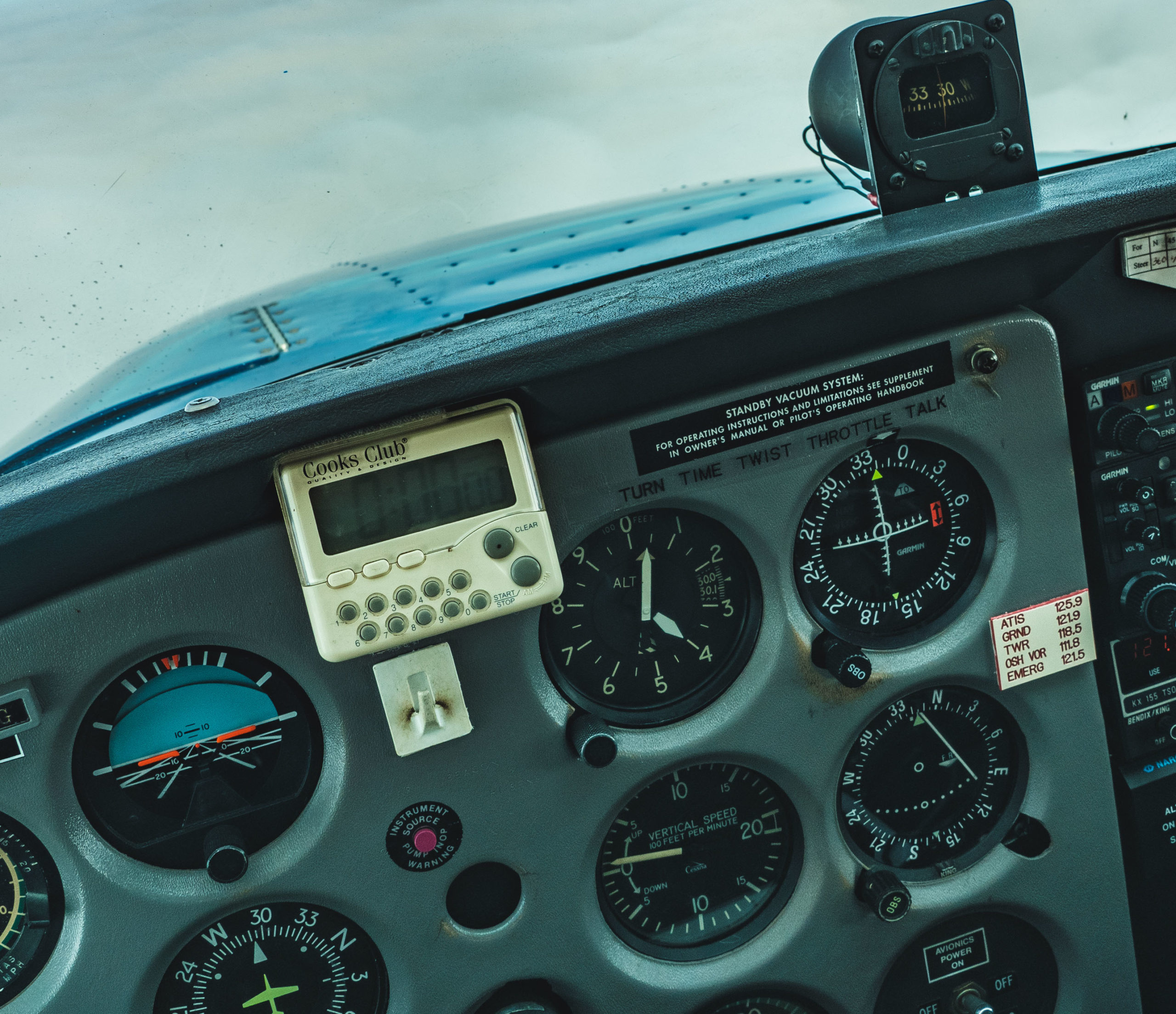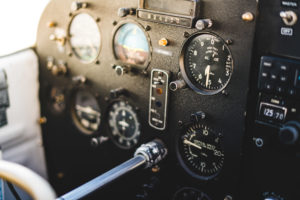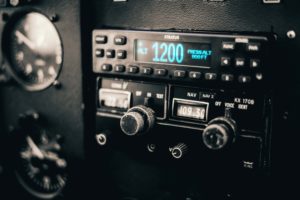
The most important six-pack you can get as a pilot is not at your local gym but on your dash. The altimeter is arguably the most important instrument of the “six-pack”. This article will explain how to read an altimeter, the types of altimeters you may encounter in your flying career, and most importantly what to do if your altimeter fails.
What is an Altimeter?
An altimeter is a device that tells you your vertical distance from either mean sea level (MSL) or above the ground (AGL). Functionally, the altimeter in your trainer is a “static-only instrument.” Meaning, it uses the pressure from the atmospheric static port to push on disk wafers (or a capsule) behind the indicator. Which then translates to an altitude reading when compared to the input pressure. This is why the altimeter has a window for you to put in the barometric pressure. ATC/ATIS will give you at almost every handoff/startup.
 Altimeters work based on the principle that for every 10 meters in altitude you gain, the air pressure decreases by roughly 1 millibar. Thus, as you go higher less pressure is put on the wafers causing the reading to climb. In short, an altimeter is nothing more than a pressure gauge.
Altimeters work based on the principle that for every 10 meters in altitude you gain, the air pressure decreases by roughly 1 millibar. Thus, as you go higher less pressure is put on the wafers causing the reading to climb. In short, an altimeter is nothing more than a pressure gauge.
If altimeters are still giving you trouble during your studies for the Written test you should try Angle of Attack’s Online Ground School. Particularly if you are studying for your instrument knowledge test, our Angle of Attack Instrument Ground School will go into all you need to know about altimeters and what to do if your instruments fail. Altimeters can be a tricky instrument, but they are an important one, and knowing as much will help you in the long run.
How to Read an Altimeter
A majority of altimeters in the small planes you will be flying are pressure altimeters. These altimeters work as described above. They read similar to a clock with the smallest hand indicating an altitude 10,000 of feet, the thicker medium-sized hand measuring an altitude of 1,000 feet, and the skinny longer hand measuring changes in 100 feet. They are easy to work on and are very reliable.
The first pressure altimeter was patented in 1928 by Paul Kollsman. At first, Kollman had a hard time selling his altimeter. He hired an Army Air Corps Lieutenant named Jimmy Doolittle (yes, that Jimmy Doolittle) to perform the world’s first instrument flight using his altimeter. The Navy adopted the Kollsman altimeter, sales soared, and the rest is history.
Are There Other Types of Altimeters?
The next most common altimeter is the GPS altimeter. This altimeter works in the same way your GPS coordinates your position. GPS altimeters have become better and better as technology has advanced, but still can be off by 500 to 1,000 feet. How to read this altimeter is very easy, as most will just give a digital numerical display.
A final altimeter you might encounter if you keep pursuing a career in flying is a radar altimeter. Radar altimeters are highly effective low to the ground, using frequencies from under the belly of the aircraft to bounce off the surface of the ground to measure height in AGL. Reading a radar altimeter is slightly more complex and you should check your specific aircraft’s operating handbook to make sure you know how to read this altimeter.
Do 5G Frequencies Affect my Altimeter?
In short, the answer is most likely no. The recent headlines which have dominated the news cycle about the FCC and FAA’s miscommunication about radio frequencies refer to radar altimeters. Radar altimeters are found on almost every commercial plane and are used for low-visibility Category III approaches and auto-land functions. Almost no Cessnas or other trainer aircraft are equipped with this form of altimeter and therefore if you were concerned that the 5G debacle would impede your flying…fear not.
What To Do When Your Altimeter Malfunctions
Altimeters are usually reliable pieces of equipment. But when your altimeter stops working, you quickly realize how hard it is to fly. If your altimeter is not functioning properly it is a serious issue that could rise to the level of an emergency. The altimeter is a part of the CFRs minimum equipment list, so if your altimeter is not responding to your pre-flight checks, you cannot go fly your airplane (nor would you want to). If your altimeter malfunctions mid-flight you need to land as soon as practical.
Fly the Airplane
This seems obvious, but it is amazing how a problem like this could totally distract a pilot from the obvious mission at hand: flying. Don’t become so fixated on any broken instrument (no matter how significant) that you forget to avoid the ground. The first and most important thing to do if the altimeter breaks is to fly the airplane.
If you are in visual flight conditions, it is easier to focus on the altimeter problem without completely losing your sense of direction. But in instrument meteorological conditions (IMC) things become a little more difficult. If you are in IMC and lose a proper altimeter reading, you need to get to visual conditions as soon as practical. Request a heading from ATC that will get you to visual conditions. Then you can begin working on fixing the broken altimeter while referencing a backup altimeter. If no backup altimeter is available, you will need to try and focus on your vertical speed indicator (VSI). Your attitude indicator keeps you as level as possible as you try to get to visual conditions.
Check the Barometric Pressure Setting
If your altimeter starts to indicate an abnormal reading, there are a number of potential causes. One of the first things you should do is make sure you have the proper barometric pressure-tuned into your altimeter. A barometric setting lower than the actual bromic pressure will indicate an altitude lower than where you actually are. Similarly, a barometric setting that is higher than the actual barometric pressure will indicate a higher altitude.
Pull the Alternate Static Air Value
If the altimeter still isn’t coming alive the next most important thing to do is pull the alternate static air value. What may be happening is something is blocking your outside static air port. If that something is ice, you have problems and need to seek warmer air as soon as practical.
Pulling the alternate static air will open a valve located behind the instrument panel near the controls or it may be the valve itself. If the issue is a blockage this should fix the issue immediately.
Use your Electronic Flight Bag and/or Transponder
As mentioned above, this is where redundancy becomes key. If you have a GPS, ForeFlight, or anything that could give you an altitude reading you need to use it. Whatever it takes to figure out your altitude.
 Additionally, your transponder will likely have an altimeter function on it as well. That will give out a reading regardless if your static port is blocked. This gives an altitude indication to ATC as well, so another possibility would be asking ATC for periodic altitude call-outs until you got to visual conditions. Keep in mind these will likely not be as accurate.
Additionally, your transponder will likely have an altimeter function on it as well. That will give out a reading regardless if your static port is blocked. This gives an altitude indication to ATC as well, so another possibility would be asking ATC for periodic altitude call-outs until you got to visual conditions. Keep in mind these will likely not be as accurate.
Breaking another instrument?
This should probably only be done as an incredibly last and dire resort. If there is no static pressure source from which to get a reading you can create your own. This is done by breaking the glass on the VSI indicator. This is risky, and in some cases, may not work, but the science checks out. You should make absolutely sure that you have no other way to get an altitude reading before doing this. If you go Hulk Hogan on your VSI there is no turning back and you could be stuck without two vital instruments of the six-pack. Please remember if you do this to your VSI, and if it still functions, will work in reverse. (climbing will be shown as a decrease in fpm and descending will be indicated as a climb)
The altimeter is a crucial instrument. The importance of how to read an altimeter cannot be understated, so it’s vital you know what is an altimeter and how to use it effectively. If you’re having a hard time figuring out how to read an altimeter or what to do if your altimeter fails, take a look at our lessons on altimeters and the entire instrument six-pack in our Angle of Attack Online Ground School.

Michael Brown grew up flying on the banks of the Tennessee River in Chattanooga, TN. He obtained his private pilot’s license in high school and has instrument and seaplane ratings. Michael graduated from Texas Christian University, where he founded the school’s flying club, with a double major in Business and Communications. He is currently a law student at Tulane University, studying transportation law. Michael was named the Richard Collins Young Writing Award winner and has had his legal writing recognized by the American Bar Association’s Air & Space Subcommittee. When he is not flying or studying, Michael enjoys riding his bike and cheering on his Atlanta Braves.

Stay Connected
Be the very first to get notified when we publish new flying videos, free lessons, and special offers on our courses.





